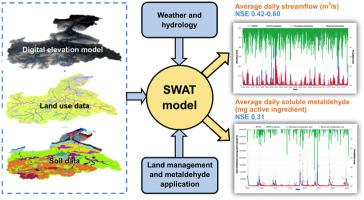Water Research ( IF 12.8 ) Pub Date : 2020-06-17 , DOI: 10.1016/j.watres.2020.116053 Sarah Purnell 1 , Rebecca Kennedy 2 , Elin Williamson 2 , Renji Remesan 3

|
Metaldehyde (a synthetic aldehyde pesticide used globally in agriculture) has been internationally identified as an emerging contaminant of concern. This study aimed to integrate existing water industry, publicly available and purchased licensed datasets with the open-access Soil and Water Assessment Tool (SWAT), to establish if these datasets could be used to effectively model metaldehyde in river catchments. To achieve the study aim, a SWAT model was developed and calibrated for the River Medway catchment (UK). The results of calibration (1994–2004) and validation (2005–2016) of average daily streamflow (m3/s) showed that the SWAT model could simulate water balance well (P-factor 0.68–0.85 and R-factor 0.54–0.82, NSE 0.42–0.60). Calibration (P-factor 0.72 and R-factor 1.35, NSE 0.31) and validation (P-factor 0.49 and R-factor 1.37, NSE 0.16) for daily soluble metaldehyde (mg active ingredient) load was also satisfactory. The most sensitive pesticide parameters for metaldehyde simulation included the timing and amount of pesticide (kg/ha) applied to the hydrological response units, the pesticide percolation coefficient and pesticide application efficiency. Outputs from this research demonstrate the potential application of SWAT in large complex catchments where routine monitoring is in place, but isn’t designed explicitly for the purpose of predictive modelling. The implications of this, are significant, because they suggest that SWAT could be applied universally to catchments using existing water industry datasets. This would allow more efficient use of historical datasets and would be applicable in situations where resources are not available for additional targeted monitoring programmes.
中文翻译:

通过将现有的水行业数据集与土壤和水评估工具相结合,对甲醛进行预测。
甲醛(一种在全球范围内用于农业的合成醛农药)在国际上已被确定为令人关注的新兴污染物。这项研究的目的是将现有的水工业,可公开获得和购买的许可数据集与开放获取的土壤和水评估工具(SWAT)进行整合,以确定这些数据集是否可用于有效模拟河流集水区中的甲醛。为了达到研究目的,开发了SWAT模型并针对梅德韦河汇水区(英国)进行了校准。平均日流量(m 3)的定标(1994–2004)和验证(2005–2016)的结果/ s)表明,SWAT模型可以很好地模拟水平衡(P因子0.68–0.85和R因子0.54–0.82,NSE 0.42–0.60)。每日可溶性甲醛(mg有效成分)负载量的校准(P因子0.72和R因子1.35,NSE 0.31)和验证(P因子0.49和R因子1.37,NSE 0.16)也令人满意。用于模拟甲醛的最敏感的农药参数包括施用于水文响应单位的农药的时间和用量(千克/公顷),农药的渗透系数和农药的施用效率。这项研究的结果证明了SWAT在具有常规监控功能的大型复杂集水区的潜在应用,但并不是为预测建模而明确设计的。这的意义是重大的,因为他们建议使用现有的水行业数据集将SWAT普遍应用于流域。这将允许更有效地使用历史数据集,并将适用于没有资源可用于其他目标监视计划的情况。


























 京公网安备 11010802027423号
京公网安备 11010802027423号